Revolutionizing Systems Engineering With AI for the Defense Community
In the rapidly evolving landscape of systems engineering and project management, artificial intelligence (AI) is no longer a luxury—it’s a necessity....
%20(200%20%C3%97%20100%20px)%20(800%20%C3%97%20400%20px)%20(6).png)
Could Good Systems Engineering Have Prevented the OG Jurassic Park from Failing?
The chaotician, Ian Malcolm, predicted that Jurassic Park Island will quickly proceed to behave in an "unpredictable fashion" and that it was "an accident waiting to happen.”
In case you don’t remember the 1993 Jurassic Park, John Hammond almost realizes his dream of a zoo-like amusement park with live dinosaurs. His dreams come to a halt when the severely underpaid Dennis Nedry turns the park’s system off to steal InGen’s property, resulting in the dinosaurs’ escape and sending our heroes on a mission to escape Jurassic Park.
Could Systems Engineering and some good Project Management have prevented the disaster that befalls our main characters and save Jurassic Park? We think so. Jurassic Park is a perfect example of a system failure due to a lack of systems engineering. Here are our top 8 fails that systems engineering would have fixed.
1) Not Listening to Your SMEs: A vital role of systems engineering is to listen to your Subject Matter Experts (SMEs). This is Hammond’s biggest failure. The insurance company required experts to inspect the park: Dr. Sattler, a paleobotanist, Dr. Grant, a paleontologist, and Dr. Malcolm, a chaotician. Hammond thought it was unnecessary to bring them in and minimized their opinions when they did not align with his goals. He also disregarded his staff’s opinions frequently. Communicating with your SMEs is so vital that it is usually the first part of the system lifecycle and part of the concept phase. Hammond did not even bring them in until the testing phase.
2) Not Enough Time Spent in the Concept Phase of the Lifecycle: Ian Malcolm points out, “Your scientists were so preoccupied with if they could, that they didn’t stop to think if they should.”
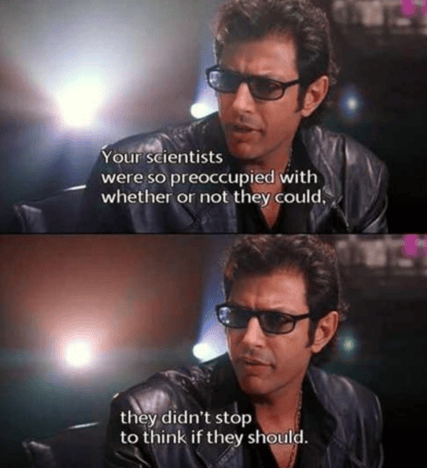
Ian claims that before Hammond “even knew what he had,” he jumped into productizing and marketing. Hammond would have benefited from spending more time analyzing the problem space. This is to make sure you identify what you know and what you don’t know.
What Should InGen Have Known?
Dr. Henry Wu assures the SMEs that “population control is one of our security measures.” InGen assures “all the animals in Jurassic Park are female.” However, they should have researched more about the frog DNA that they were using and known that 2-16% of frogs can change their sex.
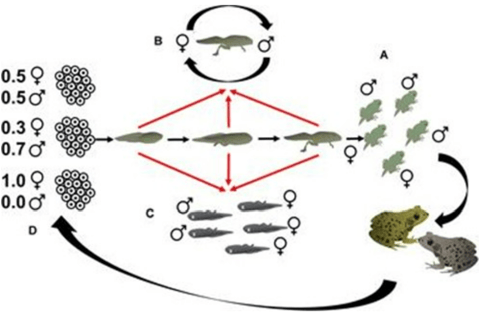
Credit to https://www.frontiersin.org/articles/10.3389/fevo.2021.756476/full
InGen should have known from other types of amusement parks that they need the ride vehicles to have lock mechanisms on the doors. This is just another small glitch that foreshadows the major disaster.
What Should InGen Have Known That They Don’t Know?
As Dr. Settler and Dr. Grant pointed out, there’s only so much we could know about 65 million years ago. Understanding your unknowns is another important part of the concept phase.
Systems engineering can help remove some of the chaos by understanding our knowns and unknowns.
3) Not Quality Checking and Instead Making Assumptions: Dr. Sattler points out, “Well, the question is, how can you know anything about an extinct Eco-system? And therefore, how could you ever assume that you can control it?”
At one point in the movie, Dr. Sattler hops out of her jeep to assist with a sick triceratops. She guesses that the dinosaur is eating toxic plants. The InGen attendee says, “We know they are toxic, but the animals don’t eat them.” If InGen had run their requirements through a quality checker, they would have found these assumptions.
4) Not Understanding Relationships in the System: The key to understanding emergent behavior is to analyze the relationships. Pulling up a spider diagram to visually see how one change can affect the entire system would have prevented the main reason Jurassic Park failed. The security systems being controlled by one person would be easy to see on a spider diagram. You would immediately see the issue and put in a mechanism/procedure that would prevent one person from being able to turn off the entire security system, including electric fences that hold a giant T-Rex.
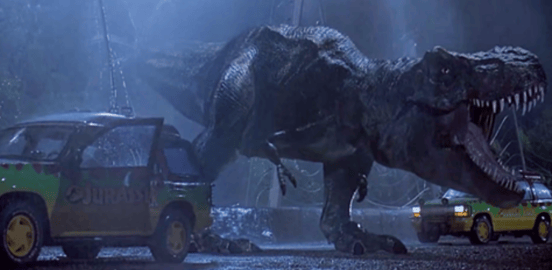
5) Not Modeling Constraints, Causing Poor Project Planning: Their lead software developer, Dennis Nedry points out, “We can run the whole park from this room, with minimal staff, for up to three days. You think that kind of automation is easy? Or cheap?”
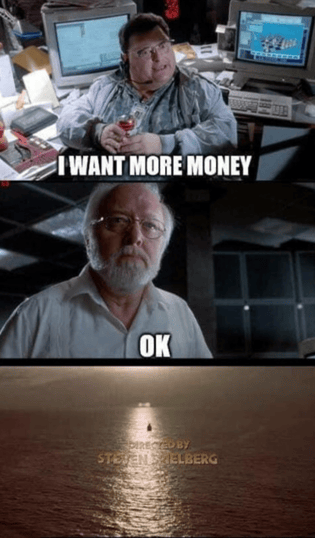
Hammond prioritized his magnificent dream of a dinosaur park over proper planning. He ran out of money and didn’t have what he needed to pay his vital staff members.
InGen would have benefited from developing functional and physical models with the ability to simulate cost, schedule, and time. The Discrete Event Simulator can do this exactly. Hammond could have seen his system constraints and known that he couldn’t quite afford his vision. Seeing this, maybe he would have properly allocated enough money to the one staff member who has the power to run the entire park.
6) Not Assessing Risks:
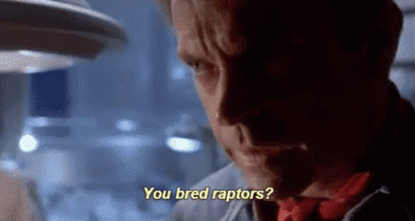
Jurassic Park opens with a raptor killing an InGen employee while trying to feed the raptors. InGen was not just assessing risks; they were completely disregarding the risks. They made some small adjustments by having a cow dropped into the raptor enclosure, but that was not enough.
They were breeding carnivorous dinosaurs from the inception of the park. After a risk assessment, they could have determined that they needed to manage less dangerous dinosaurs. Muldoon, InGen’s game warden, warns that the raptors can move 50-60 miles per hour and have problem-solving intelligence. The raptors were testing the fence for weakness systematically. Therefore, the raptors nearly won. They were doing some solid systems thinking.
As Dr. Grant said, “You can’t suppress 65 million years of gut instinct.” One way that InGen could have benefited was by performing a risk analysis with a risk burndown chart, and a park full of live, carnivorous dinosaurs is going to need to do some serious risk analysis.
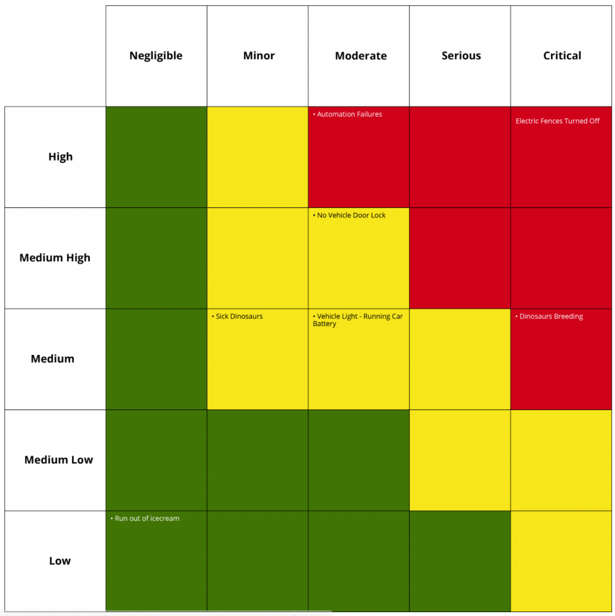
“Genetic power’s the most awesome force the planet’s ever seen, but you wield like a kid that’s just found his dad’s gun.” – Ian Malcolm
7) Not Taking the Testing Phase Seriously:

We already know that InGen didn’t invest the time into quality requirements, so it’s no surprise when Chief Engineer, John Arnold, said, “Item 151 on today’s glitch list.” However, the few requirements they did have were not being tested with care.
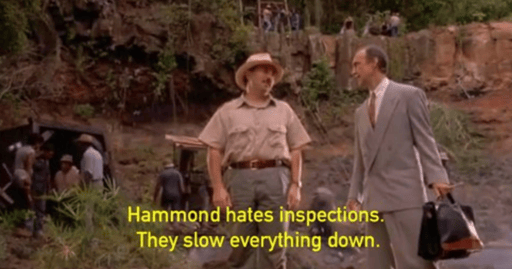
Hammond didn’t want to have his park inspected, which is an important part of the testing phase. Hammond was arrogant and believed nothing could go wrong. Systems engineering is all about expecting all possible outcomes. The testing phase is imperative and probably would have fixed a lot of InGen’s poor initial planning in the concept phase. Hammond was so careless with the testing phase that he even invited his grandchildren to be guinea pigs.
8) Not FMECA Planning:
When everything went wrong, no one knew what to do. There was no plan for failure. That’s where some Perform Failure Modes and Effects Criticality Analysis (FMECA) would have helped. FMECA is a critical analysis required for ensuring the viability of a system during the operations and support phase of the lifecycle. A major part of FMECA is understanding the failure process and its impact on the operations of the system
There are hints throughout the movie that the park had poor systems engineering and would have failed, even if it had not been the dramatic failure during that initial test. If InGen and Hammond had implemented good systems engineering from the start, our heroes could have simply had an amazing vacation to the first-ever live dinosaur park.
Hammond would have understood the risks and developed new, safer processes and plans, and the park may even be celebrating its 30th anniversary soon. If InGen had invested in the demolition and disposal phase of the system, we probably wouldn’t have any of the sequels.
Discover the capabilities of Innoslate, SPEC Innovations’ cutting-edge product, and unleash your organization’s full potential. Sign up for your free, sandbox account today.
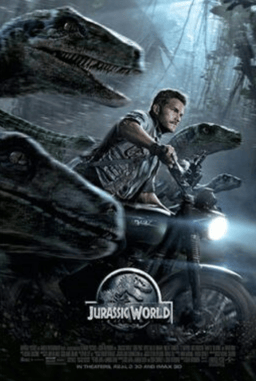
Have questions about model-based systems engineering or requirements management? Talk to an expert and see how Innoslate can streamline your projects from start to finish.

In the rapidly evolving landscape of systems engineering and project management, artificial intelligence (AI) is no longer a luxury—it’s a necessity....

Standard Operating Procedures (SOPs) play a vital role in systems engineering, ensuring that complex processes are carried out efficiently and...

This playful project in Innoslate illustrates potential in-game scenarios and their outcomes, emphasizing the role of probability and choice on the...